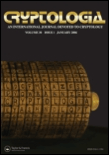
CRYPTOLOGIA
Scope & Guideline
Pioneering Research in Secure Information Systems
Introduction
Aims and Scopes
- Historical Analysis of Cryptography:
One of the core areas of CRYPTOLOGIA is the examination of historical cryptographic techniques and their evolution. This includes the study of historical figures, events, and artifacts that have shaped the field. - Mathematical and Algorithmic Approaches:
The journal consistently features research that involves mathematical modeling, algorithmic development, and cryptanalysis techniques, focusing on both classical and contemporary cryptographic systems. - Interdisciplinary Studies:
CRYPTOLOGIA encourages interdisciplinary research that intersects with history, mathematics, computer science, and political science, highlighting the multifaceted nature of cryptology. - Technological Innovations:
The journal also places emphasis on technological advancements in cryptography, including the application of machine learning, artificial intelligence, and quantum computing to cryptographic problems. - Educational Contributions:
Another important scope includes contributions that address educational methods and resources for teaching cryptography at various academic levels.
Trending and Emerging
- Artificial Intelligence in Cryptography:
Recent publications have highlighted the application of artificial intelligence and machine learning in cryptography, such as using neural networks for cryptanalysis, marking a significant trend towards integrating advanced computational techniques. - Post-Quantum Cryptography:
The focus on post-quantum cryptography has emerged as a crucial area of interest, driven by the need to secure cryptographic systems against potential quantum computing threats. - Digital Forensics and Cryptanalysis:
There is an increasing emphasis on digital forensics and the analysis of encrypted data, reflecting the growing importance of cybersecurity and data protection in the digital age. - Cryptographic Protocols and Standards:
Emerging research is also focusing on the development and evaluation of cryptographic protocols and their implications for modern communication systems, highlighting the need for secure standards in an interconnected world. - Cultural and Historical Contexts of Cryptology:
A growing interest in the cultural and historical contexts of cryptology is evident, as researchers explore how different societies have approached cryptography and codebreaking, thus broadening the journal's scope.
Declining or Waning
- Classical Cryptography Techniques:
Research focusing on classical cryptographic techniques, such as simple substitution ciphers or historical cipher machines, appears to be less frequent as the field shifts towards more complex and modern cryptographic systems. - World War II Era Codebreaking:
Although the World War II codebreaking narratives have been significant in the past, there seems to be a waning interest in this theme as more contemporary issues and technologies come to the forefront. - Political History of Cryptology:
While the intersection of politics and cryptology has been a popular subject, recent publications indicate a decrease in papers that focus on political narratives, possibly due to the increasing technical emphasis in current cryptological research. - Physical Security and Espionage Techniques:
There is a noticeable decline in studies related to physical security measures and espionage techniques, as the journal increasingly focuses on digital cryptography and cybersecurity challenges.
Similar Journals

JOURNAL OF CRYPTOLOGY
Transforming Ideas into Innovations in Secure CommunicationJOURNAL OF CRYPTOLOGY, published by SPRINGER, stands at the forefront of research in the domains of applied mathematics, computer science applications, and software security. With a history of significant contributions since its inception in 1988, this esteemed journal encompasses a broad range of topics in cryptology, including but not limited to encryption, security protocols, and information security systems. Holding a prestigious Q1 classification in multiple fields, it ranks #45 out of 635 in Applied Mathematics and has esteemed positions in Computer Science categories, reflecting its influence and recognition in the academic community, as evidenced by its high percentiles. As a vital resource for researchers, professionals, and students, the JOURNAL OF CRYPTOLOGY not only aims to disseminate innovative findings and methodologies but also fosters an engaging discourse within the cryptology and cybersecurity realms. Notably, it offers access through traditional subscription models, ensuring that readers benefit from a rigorous selection of high-impact research articles. Explore groundbreaking advancements and contribute to the ongoing dialogue in this pivotal field through your engagement with our journal.

Science China-Information Sciences
Empowering Innovation Through Open Access Research.Science China-Information Sciences is a prestigious academic journal published by SCIENCE PRESS, dedicated to advancing knowledge in the field of information sciences and computer science. Established in China, the journal has gained a remarkable reputation, with a 2023 category quartile ranking of Q1 in Computer Science (miscellaneous) and an impressive Scopus rank of #16 out of 232 in General Computer Science, positioning it within the 93rd percentile. The journal embraces a broad spectrum of topics, from theoretical frameworks to practical applications, providing a platform for researchers, professionals, and students to disseminate their findings and engage with the latest advancements in the field. With open access options available, Science China-Information Sciences ensures that innovative research is accessible to a global audience, fostering collaboration and interdisciplinary dialogue. The journal not only reflects the evolving landscape of information sciences but also plays a pivotal role in shaping future research directions.
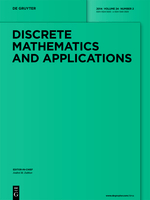
Discrete Mathematics and Applications
Fostering Collaboration in the World of Discrete Mathematics.Discrete Mathematics and Applications, published by WALTER DE GRUYTER GMBH, is a vital academic journal catering to the expansive fields of Discrete Mathematics and Applied Mathematics. With an ISSN of 0924-9265 and an E-ISSN of 1569-3929, it serves as a reputable platform for disseminating innovative research and developments within these domains. The journal has been contributing to the academic landscape since its inception in 1991 and continues to actively publish impactful studies through 2024. Despite its current positioning in Q4 of both the Applied Mathematics and Discrete Mathematics and Combinatorics categories, the journal is dedicated to fostering essential discussions that advance understanding and application of discrete mathematical concepts. It provides researchers, professionals, and students with access to a wealth of knowledge, encouraging collaboration and growth within the field. With its strategic German headquarters in Berlin and a focused aim to enhance the visibility and significance of discrete mathematics in real-world applications, Discrete Mathematics and Applications stands out as an important resource for those seeking to contribute to the ongoing evolution of mathematical sciences.
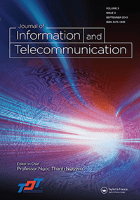
Journal of Information and Telecommunication
Connecting Minds, Advancing Knowledge in Information and Telecommunication.Journal of Information and Telecommunication, published by TAYLOR & FRANCIS LTD, is a distinguished open access journal that has been enhancing the global discourse since its establishment in 2017. With an ISSN of 2475-1839 and an E-ISSN of 2475-1847, this journal is located in the United Kingdom and dedicates its focus to the fields of information technology, telecommunications, and related disciplines. Boasting a respectable Q2 quartile ranking across various categories including Computer Networks and Communications, Electrical and Electronic Engineering, and Computer Science Applications in 2023, it ranks notably in the top percentiles of scopus rankings, asserting its significance in the academic community. The journal's commitment to open access since its inception has fostered widespread accessibility, encouraging research dissemination and collaboration on a global scale. By providing a platform for high-quality research, it aims to unite researchers, professionals, and students in their pursuit of innovation and excellence in the ever-evolving digital landscape.

Cryptography and Communications-Discrete-Structures Boolean Functions and Sequences
Unraveling the complexities of sequences in secure data processing.Cryptography and Communications - Discrete Structures, Boolean Functions and Sequences is a distinguished journal published by Springer, focusing on the crucial intersections of cryptography, discrete mathematics, and communication systems. With a significant presence in the academic community since its inception in 2009, the journal has established a robust reputation, holding a Q1 ranking in Applied Mathematics and notable positions in other relevant categories, reflecting its impact in the field. Researchers and professionals will find this journal engaging as it rigorously explores the theoretical underpinnings and practical applications of boolean functions and sequences, essential for advancing secure communication protocols and efficient data processing. Despite not currently offering open access, the journal is highly regarded for its quality peer-reviewed articles, making it a vital resource for scholars aiming to contribute to or stay at the forefront of cryptographic research. Its continual publication through 2024 ensures an ongoing dialogue in this rapidly evolving field, enhancing understanding and innovation among its readership in the United States and beyond.
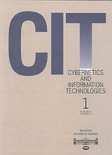
Cybernetics and Information Technologies
Navigating the Frontiers of Information ScienceCybernetics and Information Technologies is a pivotal academic journal, published by the Institute of Information and Communication Technologies at the Bulgarian Academy of Sciences. With its Open Access policy established since 2012, this journal facilitates wide dissemination of cutting-edge research across the field of computer science, particularly in the intersections of cybernetics and information technology. Indexed in Scopus, it holds a commendable position within the Q3 quartile for 2023, ranking #103 of 232 in the category of General Computer Science, placing it within the 55th percentile and attesting to its growing influence among peer publications. The journal not only aims to publish high-quality research but also seeks to foster a collaborative platform for academicians, practitioners, and students to advance the domain of computational technologies. With a focus on innovative methodologies and applications, Cybernetics and Information Technologies remains committed to addressing current challenges and exploring the future landscape of technology and information systems.
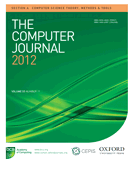
COMPUTER JOURNAL
Fostering Academic Dialogue in the Digital AgeCOMPUTER JOURNAL, published by Oxford University Press, is a distinguished platform for innovative research in the field of computer science, with a focus on general and miscellaneous aspects. The journal, established in 1967, continues to advance the boundaries of knowledge in computational technologies, algorithms, and interdisciplinary applications, contributing to its impressive ranking of Q2 in the 2023 Scopus category for Computer Science. With a robust ISSN of 0010-4620 and E-ISSN 1460-2067, it serves as a vital resource for researchers, professionals, and students seeking to stay at the forefront of technological advancements. Though not an open-access journal, it provides numerous access options via institutional subscriptions, making its high-impact articles widely available, especially as the journal bridges over five decades of research from 1967 to 2024. The COMPUTER JOURNAL is committed to fostering scholarly communication and ensuring that critical insights in the ever-evolving realm of computer science reach a diverse audience, thus solidifying its role as an essential resource in academia.

Cryptography
Advancing Knowledge in Information SecurityCryptography, an esteemed journal published by MDPI, focuses on the rapidly evolving fields of cryptography and information security, providing a platform for researchers and practitioners to share their findings and advancements. Since its inception in 2017, it has embraced an Open Access model, allowing unrestricted access to high-quality research articles, thereby fostering collaboration and innovation among academics globally. Based in Switzerland, this journal aims to cover a broad spectrum, from theoretical foundations to practical applications, contributing significantly to fields such as Applied Mathematics and Computer Science. Its impressive rankings in reputable databases like Scopus reflect its relevance and quality, holding a Q2 category in multiple disciplines, including Computational Theory and Mathematics and Computer Networks and Communications. With the continuous rise in importance of cybersecurity and data protection, Cryptography serves as a vital resource for professionals, students, and researchers dedicated to advancing knowledge in these critical areas.

Digital Communications and Networks
Innovating the future of communication technologies.Digital Communications and Networks, published by KEAI PUBLISHING LTD, stands at the forefront of research in the rapidly evolving fields of communication, computer networks, and hardware architecture. Since its inception in 2015, this open access journal has been committed to disseminating high-quality, peer-reviewed articles that contribute to technological advancements and academic discourse in these critical domains. With an impressive Impact Factor and achieving Q1 Quartile rankings in its relevant categories for 2023, it has established itself as a vital resource for researchers, professionals, and students aiming to stay ahead in a competitive landscape. The journal's robust standing is reflected in its notable Scopus rankings, underscoring its influence in Computer Science and related fields. As we look toward the future, the journal continues to invite innovative research that shapes the digital communication landscape until 2024 and beyond.

Journal of Mathematical Cryptology
Fostering Collaboration in the Evolving Landscape of CybersecurityThe Journal of Mathematical Cryptology, published by DE GRUYTER POLAND SP Z O O, is a pioneering open-access journal that has been a valuable resource for researchers and professionals in the field of mathematical cryptography since its inception in 2007. With an ISSN of 1862-2976 and an E-ISSN of 1862-2984, this journal provides a platform for cutting-edge research, aiming to address the complexities and challenges presented by the evolving landscape of cybersecurity. As of 2023, the journal holds a respectable Q3 ranking in Applied Mathematics, Computational Mathematics, and Computer Science Applications, reflecting its relevance and growing impact within these disciplines. Although it currently has an H-index of "-", the qualitative contributions of the journal are recognized through its Scopus rankings, including a placement in the 58th percentile for Applied Mathematics. The journal is committed to fostering collaboration and innovation in mathematical methodologies applied to cryptography, thus attracting a diverse audience of researchers, students, and industry professionals. By embracing an open-access model since 2020, the Journal of Mathematical Cryptology enhances the visibility and accessibility of essential research findings, making it a crucial resource in the academic community.